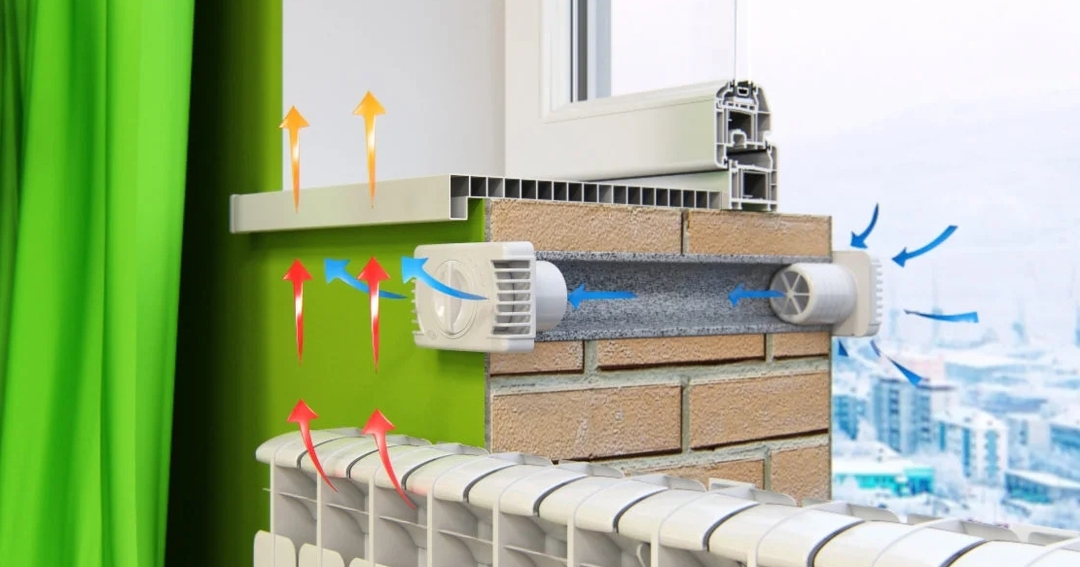An eternal headache for installers and designers: where to put the air conditioner drain. No one is satisfied with the installation of a drainage box through the entire wall, the neighbors below complain about the water dripping from the drain hose around the clock. Agree, this issue deserves a more worthy solution.
You will learn all about the formation, collection and discharge of condensate that accompanies the operation of a household split system from our article. We will tell you how best to dispose of it with minimal inconvenience to yourself and others. Consider the recommendations for installing the drain hose and methods for its output.
The content of the article:
- Causes of condensation and discharge paths
- Health Impact Assessment
-
Condensate drain options
- Method # 1: Draining to the street
- Method # 2: Disposal into the sewer
- Drain pipes for draining condensate
- Check valve for climate system
- How to choose a siphon?
- Drainage system installation
- Drainage circuit maintenance
- Checking the drain if there is no condensation
- Water drainage standards
- Conclusions and useful video on the topic
Causes of condensation and discharge paths
Warm air from the room enters the cooling radiator of the heat exchanger. There he cooling down "gives away" all the moisture contained in it. The principle of condensation can be demonstrated with a simple example. If you take any object out of the refrigerator, it will immediately be covered with water droplets. This is condensation.
The amount of condensation depends on the humidity. The more humid the air, the more condensation will be released. Please note that bacteria in dry air multiply much faster, which can cause respiratory illness. When the air conditioner is running, ventilate the room more often.

The box-type design with ball locking device can be installed in both hidden and open way. Equipped with a replaceable cassette for the possibility of replacing the dirty one. When the siphon is open, it is convenient to observe the state of the mechanism through the transparent plastic case
Why do you need condensate drainage from the air conditioner:
- Since condensate is mainly water, and the air conditioner is a complex electromechanical device, their proximity can lead to a situation with a short circuit and premature breakdown of equipment.
- In just a day, one air conditioner can produce 20 liters of condensed liquid. And from the office center, a whole ton can easily be collected. This is a serious risk of flooding in basements.
- Mold, bacteria and other pathogens develop rapidly in stagnant water.
The provided arguments are enough to understand how important it is to properly organize the drainage system to drain water from the air conditioner.
Health Impact Assessment
The danger of condensation is not only the possible flooding or breakdown of the air conditioner itself. The main threat is harm to health. There are several factors that help bacteria grow comfortably: heat, dirt, and water. What are not ideal conditions for the development of various diseases?
Black mold fungi can cause many serious diseases, including cancer. Bacteria often cause pneumonia. The death rate from "legionnaire's disease" is very high.
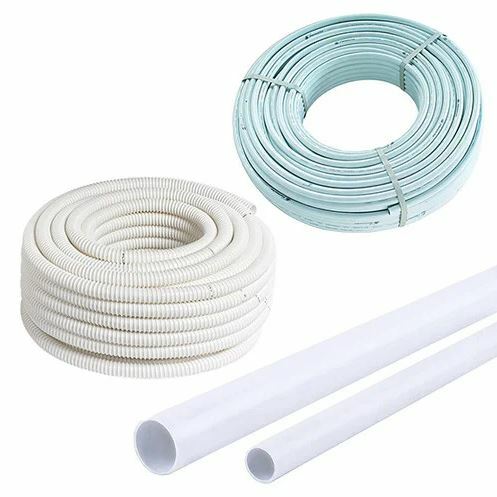
If the drain hose is clogged, disconnect and blow out. If the system was installed correctly, without kinks, accumulated dirt should fly out from the opposite end.
A disgusting smell is the least of all evils. The appearance of an unpleasant scent clearly signals the owner climate systemthat a major drainage cleaning is required.
Condensate drain options
There are several options for withdrawing the drainage of air conditioners, excluding split system flow into the room she is processing.
Method # 1: Draining to the street
A hole is drilled in a window or wall through which the hose is passed. On the one hand, the tube is connected to a branch pipe on the tray located under the evaporator, and on the other, it hangs freely onto the street.
Drainage to the street has its drawbacks:
- A hose hanging from the wall can worsen the exterior presentability of the building, which is especially important for private houses.
- Water will constantly drip from the hose, the ingress of which to the ebb of neighbors from below can lead to a scandal.
However, due to the simplicity of the work, this method is the most common.
Method # 2: Disposal into the sewer
Connecting a drain pipe to a sewer will be an excellent option for many rooms. A traditional problem is the lack of a sewerage section in an air-conditioned room.
Solution:
- In the air-conditioned room, drainage pipes are installed with a slope.
- Installation of drainage pipes with a minimum slope to the nearest site with sewerage.
The installer laying the air conditioner route must necessarily have experience in performing such work.
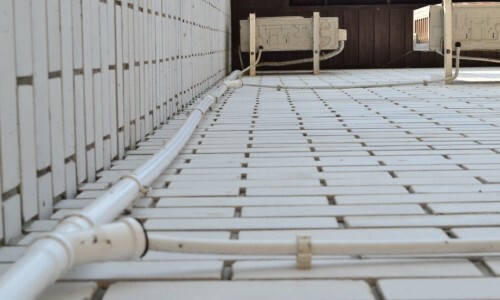
Condensate drainage into the sewer system has one significant limitation. Condensate will be discharged by gravity if there is a drain pipe slope of at least 3 degrees.
If it is not possible to provide the required slope along the entire length of the pipeline, a special drainage pump is used. With its help, the condensate can be raised to the required height for further drainage by “gravity”.
Drain pipes for draining condensate
Condensate is discharged from the air conditioner through drain pipes. Pipes used in organizing condensate drainage from the air conditioner can be made of polyvinyl chloride or polyethylene. Products made from these materials are highly durable and resistant to water.
Manufacturers of air conditioners complete their goods with tubes of two types - corrugated and smooth. The latter are found only in budget models of air conditioners and cannot be installed without special fittings.
It is possible to use smooth pipes to organize the drainage pipeline, but only if the air conditioner is located close to the sewer. If the connection to the sewage system is far away, then the installation will be greatly complicated due to the use of fittings.
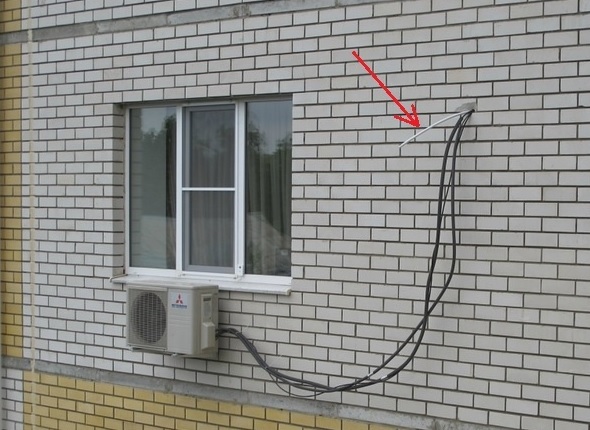
If you use a drain pipe that is too short, you will hear the whistle of the wind, which is especially true for residents of high-rise buildings. In winter, cold will blow from the indoor unit
Due to the high flexibility of the corrugated tubing, no fittings are required when installing the drainage piping. Drainage pipeline made of polymeric corrugation for condensate drain from the outdoor and indoor unit can be bent at any angle. The process of installing such a pipeline will not take much time and effort from you.
Check valve for climate system
When connected to a sewer system, the water from the air conditioner is discharged through the drain hose. Installing a check valve for the air conditioner will prevent the penetration of foreign odors into the apartment. It will allow liquid to pass through and prevent odors from penetrating in the opposite direction.
A conventional siphon equipped with a water seal has a U-shape. Water remains in the knee, which prevents the escape of sewer gases. So, during the operation of plumbing devices, there is a constant replacement of water in the water seal, due to which its level does not change.
Since during the operation of the air conditioner, the condensed water flows unevenly, the odor trap can dry out and gases will freely penetrate into the room.
The way out of the situation will be the installation of a check valve for drainage of the split system. Sewer drains and air will be blocked without obstructing condensation. The locking mechanism is a spring diaphragm or ABS ball.
When water enters the unit, the ball rises, opening access to the sewer. After the liquid has left, it will fall under its own weight, blocking the hole.
How to choose a siphon?
Siphons designed for condensate drainage have structural differences.
When choosing, consider the following criteria:
- Estimate the free space for installing the device. The dimensions of the selected model may simply not fit in the available area.
- Outlet diameter. The dimensions of the siphon inlet and the drain hose must be the same.
- The tightness of the connection is ensured by rubber seals. When installing the siphon in direct sunlight, they will quickly become unusable. In some cases, you will have to perform flush mounting.
The amount of condensate must correspond to the capacity of the unit. All the necessary information is indicated in the characteristics of the devices. If the air conditioner produces a large amount of condensation, a high flow siphon will be needed.

In some cases, the drain of the drain is installed above the level of the sump of the air conditioner itself, for example, if the air conditioner is located in a basement or basement room. Installing a drain pump will help raise the water to the required height
When choosing a built-in siphon, the depth of the niche for its installation is taken into account.
Drainage system installation
First you have to draw up a layout diagram for each element of the drainage system.
It includes:
- clamps and fasteners;
- drainage tube;
- seals and adapters;
- siphon (if it is impossible to bend the drainage tube);
- sewage pipe.
A small slope of the sewer pipe leading to the sewer itself should be organized in advance. Installing a siphon will create a water seal that prevents the access of gases from the sewer.
Since the air conditioner only works in hot weather, a possible solution would be to install a check valve between the equipment and the drain. It will be effective at any time of the year. Even if the water in the water seal dries up, there will be no extraneous odors of movement.
There are times when it is impossible to organize a gravity system. The solution is to use special containers in which condensate accumulates. As the accumulation proceeds, the container is spontaneously emptied or emptied using a pump.
For the drainage to work with the pump, an electrical connection is required. In this case, you can do without installing a check valve. The tube from the air conditioner enters the container without a direct connection to the sewer.
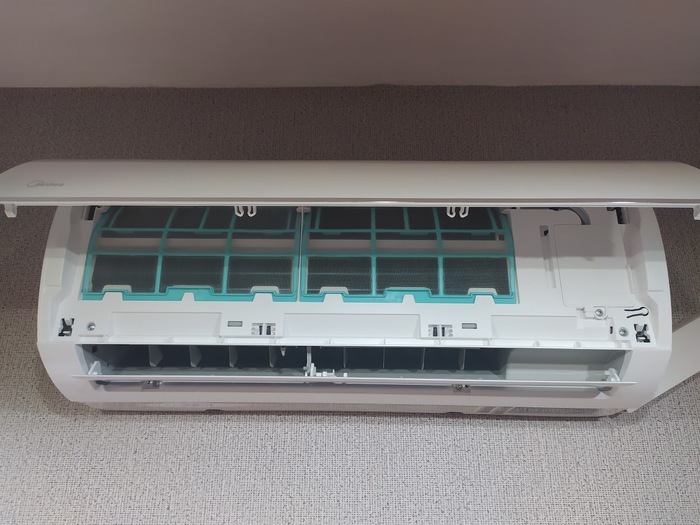
If the air conditioner starts to operate noisily after disassembly-assembly, you need to check the fasteners of the outdoor unit. Loose fasteners may cause the unit to fall over time
When installing the drainage of the air conditioner with outlet to the sewer, you should organize a horizontal section of the system and connect it to the pipe coming from the receiving bath. If the distances are too large, you will have to make holes in the walls for the pipeline.
A large number of turns can cause blockages. Short piping is easier to maintain and clean.
Drainage circuit maintenance
After the installation of the condensate drainage system, it is necessary to take care of its functional condition. There are many operational problems that need immediate attention.
Problem. Most often, the hole through which moisture is discharged into the drainage tube is clogged. The reason is dust and dirt accumulating in the hole. Debris settles and clogs the tube. The bath is filled with liquid and it begins to flow along the walls to the floor.
Solution. To avoid unpleasant consequences, you should regularly clean and rinse the tube. Detergents that contain chlorine are suitable for flushing, since it copes with the task as efficiently as possible.
Problem. If the pressure regulator is faulty, ice build-up may form on the evaporator. The reason for this is a decrease in the temperature outside, and as a result, the temperature of freon.
Solution. To prevent a malfunction, you should regularly carry out a technical inspection of the ways of draining condensate from the split system.
Problem. If the air conditioner is turned on for heating in winter, the moisture removal tube will quickly freeze, which will cause a breakdown.
Solution. If the outside temperature is below zero, the split system should be turned off. You can buy a low temperature kit designed to heat the compressor and drain tube. In this case, the air conditioner will be able to work even at a temperature of -25 degrees.
Problem. Too much or too little refrigerant can cause icing of the pipes and evaporator. The ice will melt and drip onto the floor.
Solution. Remember to keep an eye on the refrigerant level. Timely contact the service center for refueling.
Problem. If the pump breaks down, the drainage system fails.
Solution. It is better to purchase equipment from official suppliers and be responsible for the installation.
Problem. An incorrect angle of inclination of the drain tube will cause stagnant water. In the future, it will drip onto the floor.
Solution. Follow the recommendations for creating a slope even at the installation stage.
Checking the drain if there is no condensation
If condensate does not drain from the drainage pipe, and there is no desire to wait until the water flows from the indoor unit, you can diagnose the drainage system with your own hands.
Problem search is carried out in the following order:
- The air conditioner is disconnected from the power supply, the plug is removed from the socket.
- The top panel is removed from the air conditioner. It keeps on snaps. It can be removed with a slight upward movement.
- Open the case on the indoor unit. It is fixed either on latches or on screws.
- After removing the cover, access to the tray under the radiator appears - this is where condensation collects.
- A glass of water is poured into a container for collecting condensate and it is monitored whether it comes out from the other side of the drainage channel. If no water appears, then the drainage line is clogged.
The drain hose may be squashed or in the wrong position. As a result, the liquid cannot rise for free exit.

If small children, allergy sufferers, or the elderly live in the house, the indoor unit of the air conditioner and the drain should be treated with a disinfectant every year. Thus, you can reduce the likelihood of colds and allergic diseases.
It is so easy to check the drainage by gravity. When a pump is installed to pump water out of the tray, this method of checking the drainage line will not work.
Water drainage standards
There are norms for drainage of water from the SanPiN air conditioner, which prohibit the drainage of condensate to the street. It is recommended to drain the condensate into the sewerage system. Thus, you can avoid undesirable consequences of moisture deposition on the evaporator of the air conditioner.

It is highly not recommended to remove moisture into the storm system. The reason lies in the unstable operation of the stormwater. When it rains heavily, high pressure builds up there. Water can easily rise through the drain pipes and disable the air conditioner by flooding the living space
The frequency of servicing the air conditioner drain depends on the correct installation of the condensate drainage system. Use more expensive tubing that does not change its internal shape when bent. Thus, you can build a reliable system with unimpeded movement of condensate to the outlet.
Conclusions and useful video on the topic
The following video will acquaint you with the features of the drainage system for water condensed during operation of the air conditioner:
During the installation of climatic equipment, it is imperative to take into account the features of the air conditioner drainage device. If the split-system pipes were correctly laid and a water seal was installed, the operation of the unit will not cause any inconvenience to anyone. Where to dispose of condensate, it is better to decide at the design stage of the route and the location of the blocks.
Would you like to tell about your own experience in organizing drainage for climate technology? Do you have information about an interesting and practical solution to the problem? Leave your comments, please, in the block form below, ask questions, share your impressions and photos on the topic of the article.

